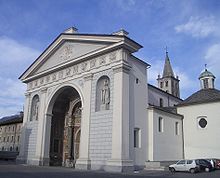Bishop of Aosta
|
Diocese of Aosta Dioecesis Augustana |
|
|---|---|

Aosta Cathedral
|
|
| Location | |
| Country | Italy |
| Ecclesiastical province | Turin |
| Statistics | |
| Area | 3,262 km2 (1,259 sq mi) |
| Population - Total - Catholics |
(as of 2006) 122,589 119,546 (97.5%) |
| Parishes | 93 |
| Information | |
| Denomination | Catholic Church |
| Rite | Roman Rite |
| Established | 4th century |
| Cathedral | Our Lady of Assumption and St. John the Baptist Cathedral, Aosta |
| Current leadership | |
| Pope | Francis |
| Bishop | Franco Lovignana |
| Emeritus Bishops | Giuseppe Anfossi |
| Map | |
 |
|
| Website | |
| www.diocesiaosta.it | |
The Italian Catholic Diocese of Aosta (Latin: Dioecesis Augustana) has existed in its modern form since 1817. It is a suffragan of the Archdiocese of Turin.
Although Ursus is sometimes said to have been the first bishop, this is controverted. The first certainly known bishop is St. Eustasius, whose name coupled with Aosta is signed to a letter sent to Pope Leo I by the second Synod of Milan in 451. In the cathedral treasury is a consular diptych of Anicius Petronius Probus, Roman consul in 406, which shows the Emperor Honorius. (It was discovered in 1833.) From the ninth century the list of bishops is fairly complete. Bernard of Menthon (1008), Archdeacon of Aosta, founded the hospice on the Alps named after him, as a relief to pilgrims.
In the 10th and early 11th centuries, the bishops of Aosta ruled the surrounding country as its secular counts. The two titles were separated at or following the death of Bishop Anselm of Aosta, in 1026, owing to Conrad II's desire to strengthen his position near the important Little St Bernard Pass and distrust of Burchard, Anselm's successor and a relative of various nobles opposed to Conrad's claims in Burgundy. (Burchard would subsequently rise in a failed revolt; he was later translated to Lyons.)
His namesake, Anselm, Archbishop of Canterbury (1033-1109), was also a native of Aosta and probably related to its dynasty of bishops; however, rather than remain in local service, he travelled to Bec Abbey in Normandy and ultimately became primate over Norman England instead.
...
Wikipedia
